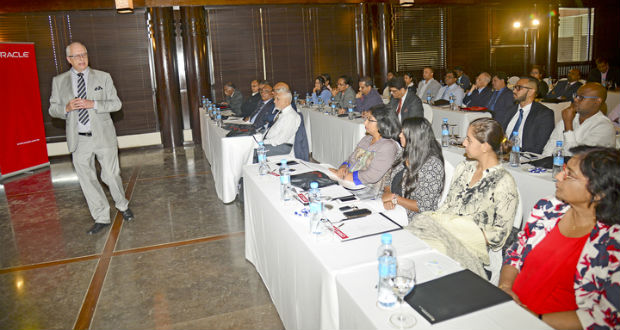Publicité
The workforce of tomorrow : E.T. phones the office
Par
Partager cet article
The workforce of tomorrow : E.T. phones the office


Robots instead of lawyers. Employees who live to see their 150th birthday. Professionals who go to the gym rather than to the boardroom. Tomorrow’s workforce will be so fundamentally different that it will almost appear alien. Are we ready for it?
The world of work is changing but not necessarily in the way that we think. On Thursday, international HR expert Ronnie Toerien was in the country on the Association of Human Resource Professionals of Mauritius’ (MAHRP) initiative to talk about what we can expect. What we can expect, it would seem, is the unexpected. Starting with artificial intelligence (AI), E.T. the alien is already knocking on our office doors, according to Toerien. In some offices, the robots have already walked through the door and made themselves comfortable at the reception desk.
In the UK, for instance, the world’s first artificial lawyer is already hard at work, providing people with legal advice online. The person who wants assistance only has to describe his situation. The robot is able to tell, based on the story, whether the person is likely to have a strong case in court or not, and why. The fact that there are now robots doing the job of lawyers is revolutionary. “Up until now, when we spoke about artificial intelligence, the fear was that the jobs of unskilled workers would disappear,” said Toerien who spoke at MAHRP’s seminar at the Intercontinental Hotel. But the lawyer profession, he added, is one of the most highly-skilled positions in the world and already, robots can beat us at it in certain situations. “It goes to show that artificial intelligence is going to have an impact everywhere,” said Toerien. It would make sense for companies to start preparing for the revolution, if they have not done so already.
Another major change that will make tomorrow’s workplace different from what we are used to now is longevity. The increase in healthy life expectancy that we have seen, is a trend that is going to continue. The world of work will not be indifferent to that change. On the contrary, it will have to adapt to it in various ways. “Today, there are people who have already been born that are going to live to be 150 years old,” said Toerien. And, not only are employees getting older but they remain fit and healthy for longer. The fact that people are expected to not only die later but are also going to be in much better shape in their 60s, 70s and 80s will change the world of work. A person expected to live to savour his 150th birthday cake is not going to retire at the age of 65. Firstly, as Toerien emphasised, the financial pension model would not allow it since it was not designed to keep people going for half a lifetime. Secondly, tomorrow’s workforce not likely to want to spend a large chunk of their lives doing nothing. While AI might be a curse or a blessing depending on the situation, longevity is purely positive since it means that the world of work will get access to experienced employees for longer.
When it comes to the challenges that companies are expected to face when dealing with the workforce of the future, labour mobility is likely to be one of the major ones. Already, employers are struggling to retain professionals of the millennial generation (people born between the 1980s and early 2000s). “The majority of companies cannot hold on to a millennial for more than three years,” said Toerien. One of the reasons, he said, is that the young generation does not have the same attitude towards work as their elders – something that companies will have to adjust to if they want to keep them. Employees of older generations are more likely to define themselves through their job. Their jobs are closely connected to their sense of self – they are what they do. But millennials did not inherit that mindset. “Older generations are work-driven but the younger generation is work-life driven,” said Toerien. “They don’t live to work – they work to live.” Wellness and free time matters more to millennials. What that means for companies is that in the future (and already, to a certain extent), employee incentives will change. A flexible work schedule or an office wellness centre with a gym might be a stronger incentive for someone to join a company than a fancy title.
Another generational change in mindsets that affects corporate culture is that the young generation expects feedback in a different, more continuous way. The annual review model does not satisfy the instant messaging and Instagram generation – it wants instant feedback, according to Toerien. To hold on to employees of the future, companies will need to keep that in mind.
One of the most important factors, when it comes to holding on to millennials is to take them to the stage where they feel engaged at work. In the same spirit as Maslow’s hierarchy of needs (a theory in psychology science that aspires to explain the forces behind what makes people motivated), there is a similar hierarchy model that explains what makes people prosper at the office. The first stage is satisfaction (Am I happy at the office?) Once that need is fulfilled, the employee moves on to the alignment step (Do I understand and perform my tasks?). The next step is commitment (wanting to stay in the position) followed by engagement which is when the employee forms an emotional connection with his job. Engaged employees are the ones who stay with the company. In the future, businesses will have to put in a real effort to get their mobility-prone professionals to that stage.
According to estimations, we are also likely to see more workplace diversity in the future. It’s a positive trend, in Toerien’s view. The strategy of reserving all key positions for members of just one specific demographic (white middle-aged men used to be a popular choice) makes zero sense, judging from the results of surveys. Organisations whose workforce is diverse in terms of age, ethnicity and gender tend to outperform their competitors. One survey showed that companies that have both women and men in leadership positions rather than just men are between 18 and 69% more profitable. When it comes to age diversity in the workplace, the future is already here. “For the first time in history, managers can have members of five generations at the office,” said Toerien. And a few decades from now, we will be able to add the solid 150-year-olds to the already diverse workforce. Buy E.T. a smartphone – the aliens are near…
Publicité
Publicité
Les plus récents






